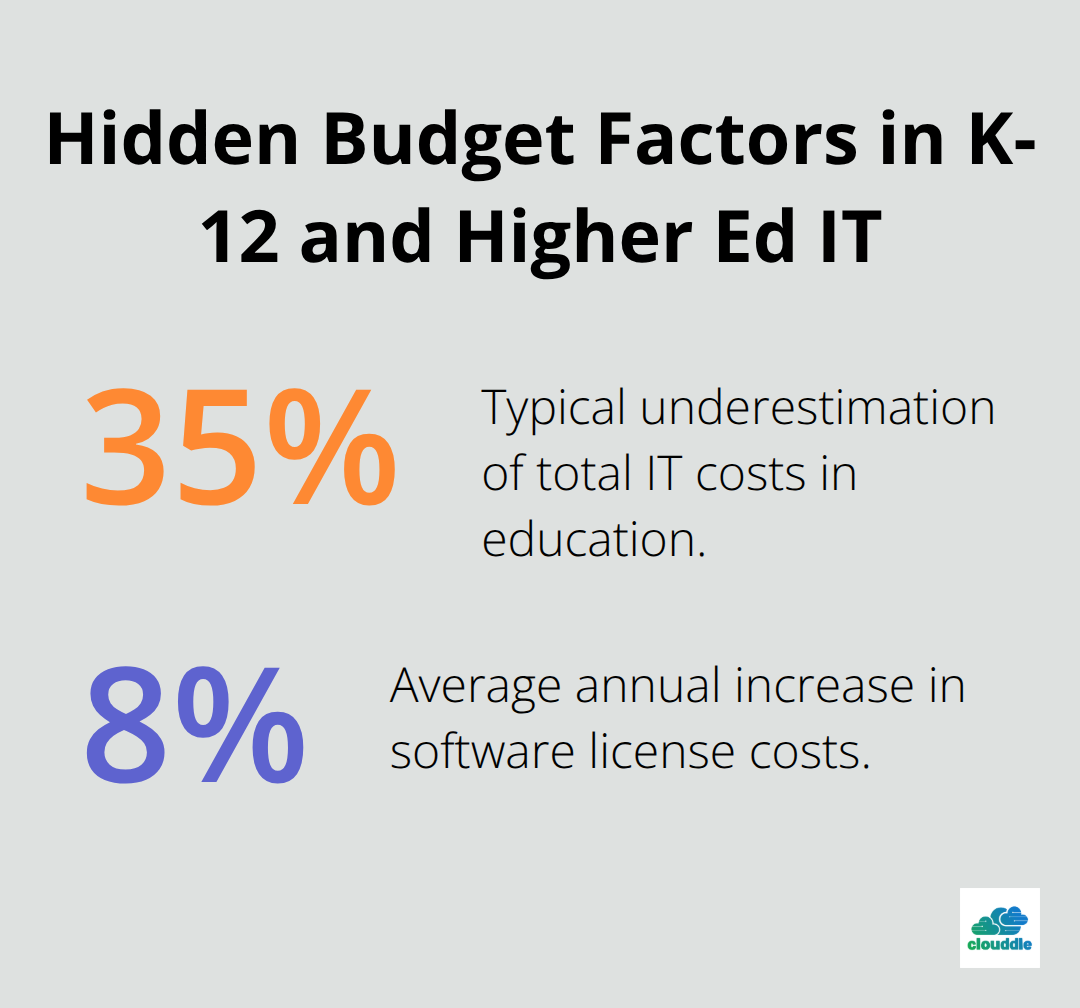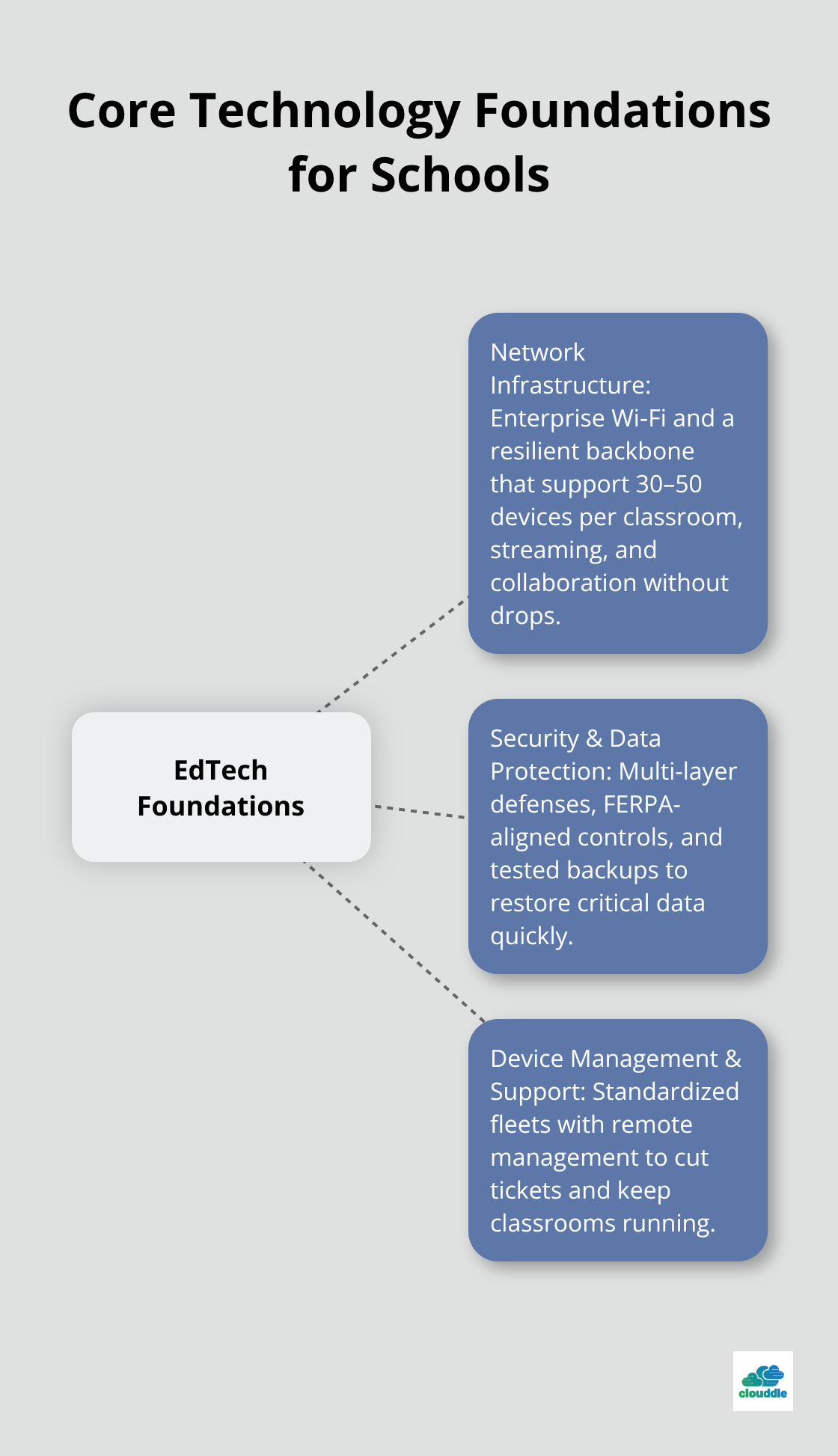Educational institutions face mounting pressure to modernize their technology infrastructure while managing tight budgets and complex security requirements.
We at Clouddle understand that selecting the right IT solutions for education industry requires balancing student needs, administrative efficiency, and long-term scalability. The wrong choice can disrupt learning environments and waste valuable resources.
This guide breaks down the essential factors every educational leader should consider when evaluating technology partners and solutions.
Understanding IT Needs in Educational Environments
Most educational institutions approach IT planning backwards. They start with vendor presentations instead of analyzing their actual operational gaps. This mistake costs schools an average of $50,000 annually in unnecessary software licenses and hardware replacements, according to McKinsey research on educational technology spending.
Assess Current Technology Infrastructure
Walk through your buildings during peak hours and document connection speeds, device performance, and user complaints. Schools typically discover that network capacity sits unused in administrative areas while classrooms struggle with 15-student Wi-Fi limits.
Test your current systems under real load conditions. Run video conferences in three classrooms simultaneously while students access cloud-based learning platforms. Most networks fail this basic stress test, which reveals immediate upgrade priorities. Document every failure point with timestamps and affected user counts. This data becomes your foundation for negotiations with IT providers.
Identify Specific Educational Requirements
Teachers spend significant time on technology troubleshooting instead of teaching. Interview department heads about their actual daily workflows – not their wishlist items. Science teachers need reliable internet for virtual lab simulations, while language arts departments require seamless document collaboration tools.
Special education programs often need assistive technology integration that standard IT solutions ignore. Create requirement matrices that connect each academic program to specific technology needs, bandwidth requirements, and uptime expectations. Schools that skip this step typically overspend on enterprise solutions while they underserve specialized educational programs.
Budget Planning and Resource Allocation
Educational IT budgets typically underestimate total costs by 35% because they ignore training, maintenance, and replacement cycles. Factor in 20 hours of staff training per new system, annual software license increases that average 8%, and hardware replacement every 4-5 years.

Include network infrastructure upgrades that support new applications. Adding tablets requires wireless capacity increases that can cost ,000 per building. Build contingency funds for emergency repairs and security incidents. Schools with comprehensive cost planning avoid mid-year budget crises and can negotiate better multi-year contracts with providers.
Once you understand your true needs and costs, you can evaluate the specific IT solutions that will transform your educational environment.
Key IT Solutions for Educational Institutions
Educational institutions need three core technology foundations that directly impact learning outcomes. Schools that implement comprehensive network infrastructure see improved student engagement in digital learning activities according to EDUCAUSE research. Modern Wi-Fi systems must handle 30-50 concurrent devices per classroom, support streaming video, cloud applications, and real-time collaboration tools. Most schools underestimate capacity needs and install consumer-grade access points that crash during peak usage periods.

Network Infrastructure That Scales With Learning Demands
Fiber-optic backbone connections should deliver minimum 1 Gbps per 100 students to prevent bottlenecks during test periods and multimedia lessons. Wireless networks require enterprise-grade access points with automatic load balancing and seamless roaming capabilities. Schools report fewer technology disruptions when they upgrade from basic wireless to managed enterprise systems.
Plan for bandwidth growth of 25% annually as educational applications become more data-intensive. Network monitoring tools help identify usage patterns and prevent outages before they affect classroom instruction. Enterprise-grade switches and routers handle traffic spikes during simultaneous video conferences and online assessments.
Security Solutions and Data Protection
Educational institutions face frequent cyberattacks according to Microsoft security reports. Multi-layered security includes firewall protection, content filtering, and endpoint detection systems that monitor all connected devices. Schools must comply with FERPA regulations while blocking inappropriate content and preventing data breaches.
Automated backup systems should run nightly with offsite storage options that restore critical data within 4 hours of any system failure. Student information systems require two-factor authentication and role-based access controls that limit data exposure to authorized personnel only. Regular security audits identify vulnerabilities before attackers exploit them.
Device Management and Support Services
Centralized device management platforms reduce IT support tickets by 45% when schools standardize on single operating systems and hardware vendors. Mobile device management software enables remote troubleshooting, application deployment, and security policy enforcement across hundreds of student devices.
Schools save ,000 annually on support costs through automated software updates and remote diagnostic tools. Asset tracking systems monitor device location, usage patterns, and maintenance schedules to extend hardware lifecycles and prevent theft losses. Help desk ticketing systems prioritize classroom emergencies over administrative requests.

These foundational technologies create the infrastructure for effective learning, but selecting the right provider requires careful evaluation of their expertise and service capabilities.
Evaluation Criteria for IT Service Providers
Educational IT providers differ dramatically in their ability to handle complex school environments. Generic IT companies treat schools like corporate offices and miss critical requirements like FERPA compliance and classroom-specific network demands. Specialized education technology providers understand that a single network outage during state testing can affect hundreds of students and require immediate emergency response protocols.
Technical Expertise and Industry Experience
Evaluate providers based on their education portfolio depth rather than general IT credentials. Companies with 50+ school implementations understand unique challenges like summer break maintenance windows, budget cycle constraints, and the need for teacher-friendly interfaces. Request references from similar-sized institutions in your geographic region and verify response times during actual emergencies.
Education-focused providers maintain spare equipment inventory locally and offer response guarantees for critical system failures. They also provide detailed documentation that meets audit requirements and can integrate with existing student information systems without daily operations disruption.
Support Services and Response Times
Look for providers who offer comprehensive staff training programs and understand the seasonal nature of educational technology needs. The right partner becomes an extension of your IT team and proactively monitors systems to prevent issues before they impact learning environments (rather than simply reacting to problems after they occur).
Emergency response protocols should include escalation procedures and direct contact numbers for after-hours support. Providers should maintain local technician teams who can arrive on-site within 2 hours for critical failures during school hours.
Scalability and Future-Proofing Capabilities
Technology partners must scale solutions from single classrooms to entire districts without major infrastructure overhauls. Cloud-based management platforms allow schools to add new buildings or upgrade capacity without replacing core systems. Providers should offer flexible contract terms that accommodate enrollment changes and budget fluctuations (typical in educational environments).
Future-ready solutions support emerging technologies like AI-powered learning platforms and virtual reality applications. Partners who invest in research and development can guide schools toward technologies that enhance learning outcomes rather than simply replacing existing systems with newer versions.
Final Thoughts
Schools that conduct systematic evaluation of infrastructure needs, security requirements, and scalability goals create technology environments that enhance learning outcomes while controlling costs. Specialized education technology providers offer distinct advantages over generic IT companies because they understand FERPA compliance requirements and classroom-specific network demands. These providers maintain local support teams and offer emergency response protocols tailored to educational environments.
Implementation success depends on comprehensive planning that includes infrastructure upgrades, staff training, and ongoing support arrangements. Schools should establish clear timelines, budget contingencies, and performance metrics before they sign contracts. The right IT solutions for education industry transform learning environments when institutions partner with providers who understand their unique operational challenges.
We at Clouddle specialize in managed IT services that support educational institutions with reliable network infrastructure and security solutions. Our Network as a Service approach eliminates upfront investments while schools receive enterprise-grade technology infrastructure. Contact us today to conduct a thorough infrastructure assessment and explore how we can support your institution’s technology transformation.


